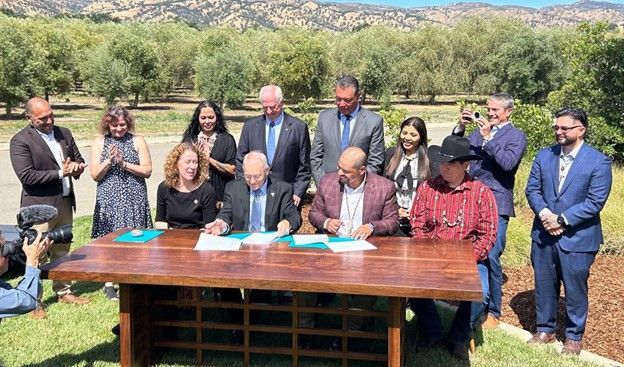Last month, President Biden added Molok Luyuk to Berryessa Snow Mountain National Monument. This month, more good news. On May 30, the US Bureau of Land Management (BLM) signed a co-stewardship agreement for Molok Luyuk with Yocha Dehe Wintun Nation and Kletsel Dehe Wintun Nation. Sandra Schubert and Nate Lillge attended the event on behalf of Tuleyome, which took place at Yocha Dehe Wintun Nation’s Séka Hills Olive Mill. Schubert and Lillge were there alongside federal, state, and local leaders, including U.S. Senator Alex Padilla, Congressman Mike Thompson, representatives for Congressman John Garamendi, State Assembly Majority Leader Cecilia Aguiar–Curry, and State Natural Resources Secretary Wade Crowfoot. Bob Schneider and Ryan Henson, both members of Tuleyome’s Advisory Council, were also present. We appreciate the decades of Tribal leadership that led to this historic agreement!
Tuleyome's Policy Corner - Berryessa Snow Mountain National Monument: Co-Stewardship and Management
The co-stewardship agreement will influence how BLM designs and implements a Resource Management Plan (RMP) for Berryessa Snow Mountain National Monument. RMPs are land management blueprints for BLM. A region’s RMP may prohibit, or allow, particular types of activities, such as Off-Highway Vehicle use, camping, or hiking. This year, BLM’s Ukiah Field Office received funds to develop an RMP for the Monument and aims to establish the RMP within two years. Until then, the 2006 Ukiah Resource Management Plan, developed long before President Obama established the Monument in 2015, directs BLM’s activities on lands within and adjacent to the Monument. A Monument-specific management plan is needed to ensure BLM enhances opportunities for public access while simultaneously protecting the region’s ecological and cultural significance.
BLM’s process for developing RMPs, explained in 43 CFR 1600, includes multiple opportunities for public feedback. A region’s RMP may be in place for several decades. As a result, RMP development processes are crucial times for Tuleyome and our community partners to shape the course of future management actions, including that related to trail construction, parking lot locations, or fire suppression activities.
BLM only manages part of the land within the Monument. The US Forest Service (USFS) also manages a portion of the region, and the 1995 Mendocino National Forest Plan directs USFS management actions on land within and adjacent to the Monument. In 2019, USFS examined whether their 1995 plan aligned with the 2015 Proclamation, which established the Monument. The 2019 assessment concluded that the 1995 plan did not need to be amended to protect the region’s ecological and cultural resources. Tuleyome is encouraging USFS to revisit this analysis to account for changed circumstances on the ground and increased knowledge, including knowledge about climate change.
USFS processes for developing management plans, described in the agency’s 2012 Planning Rule, are distinct from BLM’s. However, BLM and USFS will have to coordinate their approaches to create a Monument management plan. In September 2023, a memorandum from the BLM Director instructed BLM and USFS to develop a joint management plan for the Monument by January 30, 2026.
The 2023 memorandum also directed BLM to explore agreements regarding “parameters for engagement” with interested Tribal Nations, prior to developing a Monument management plan. Over 30 federally recognized Tribal Nations have cultural ties to lands within the Monument, but the total number of Tribal Nations with cultural connections to the region is greater, given that multiple Tribal Nations do not have federal recognition. Moving forward, on-going efforts to ensure Tribal Nations, Tuleyome, community partners, BLM, and USFS have resources to participate in Monument management planning will be needed. We are excited that management planning is occurring, and we will provide updates on opportunities for public participation as it progresses!
-Hekia Bodwitch (hbodwitch@tuleyome.org)
Policy Director
RECENT ARTICLES







